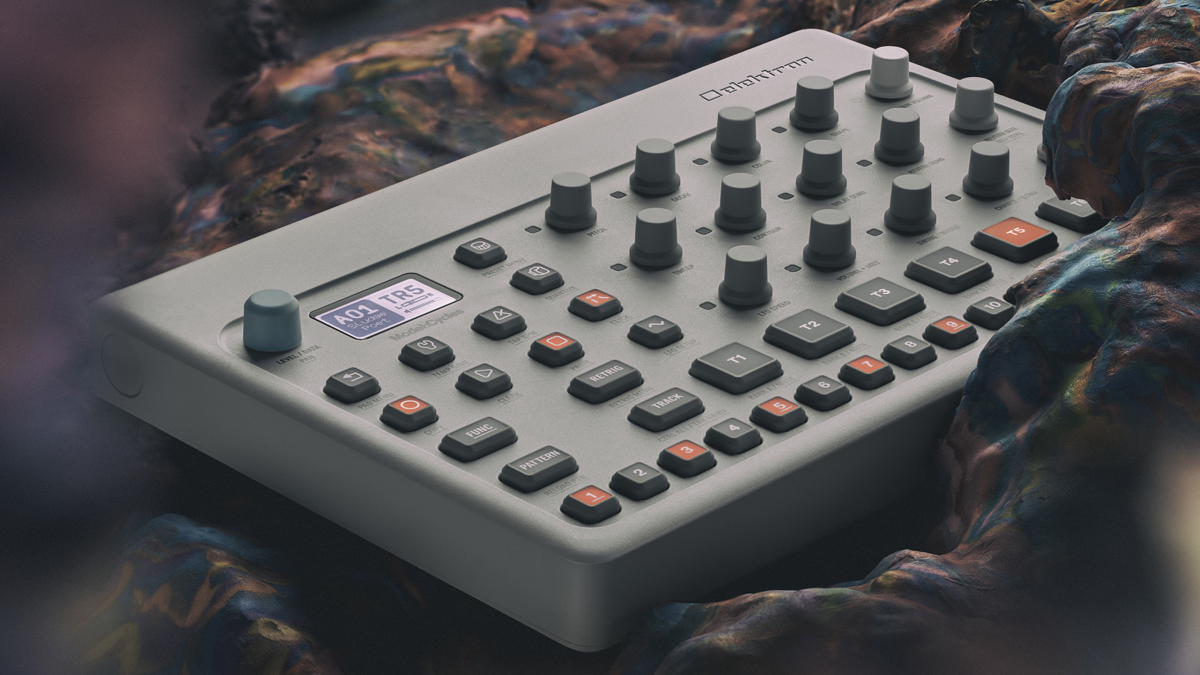MusicRadar Verdict
More than just a cut-down Digitone, this is a fun and personality-packed FM groovebox driven by a fantastic sequencer.
Pros
- +
A punchy sound engine with lots of personality
- +
Parameter and Conditional Locks are powerful sequencing tools
- +
Intuitive, hands-on workflow
- +
Well-priced
Cons
- -
Lack of individual outputs is a bit of a pain
- -
A simple arpeggiator would have been a nice touch
MusicRadar's got your back
What is it?
Elektron’s Model series made its debut with last year’s Model:Samples - a sample-powered groovebox based around the engine from the brand’s Digitakt sampler.
Housed in a white, lightweight chassis - distinct from the company’s usual dark and weighty aesthetic - the Model:Samples set itself apart with an affordable, sub-$400 price point and a workflow considerably more approachable than the deep and complex designs Elektron gear is notorious for.
In a move that will surprise nobody, Elektron is now expanding the range with a second instrument, this time based around the sound engine of the Digitakt’s sibling instrument Digitone.
As with Digitone, Model:Cycles is based around a polyphonic FM (frequency modulation) synth engine paired with a 64-step sequencer. Unlike Model:Samples, which could be described as essentially the same as Digitakt with a few features removed, Model:Cycles isn’t simply a trimmed-down version of the Digitone. Despite using the same underlying four-operator engine, the way sound editing is presented means that the two are noticeably different in use.
Whereas the ‘tone features four fully-editable synth engines, each of Model:Cycles’ six tracks is loaded with one of six varieties of Machine, which adapt the sound engine and front panel controls to facilitate the creation of a specific type of sound.
The Machines are labelled Kick, Snare, Perc, Metal, Tone and Chord, the uses of which are fairly self explanatory - the first four being staple drum sounds (Metal is essentially a hat/cymbal generator), the latter two providing monophonic and paraphonic synth sounds respectively.
- Check out our pick of the best drum machines available today
Performance and verdict
Design-wise, Model:Cycles is almost identical to Model:Samples, keeping the user interface and sequencer functionality exactly the same, with just the labeling and function of the core sound parameters differentiating the two.
As before, there’s a knob-per-function ethos whereby each of the main sonic parameters has its own front panel rotary. There are a few functions that require a shift-press, but these are generally limited to settings menus and a few less ‘hands-on’ parameters.
What is different here is that the function of some rotaries changes depending on the currently loaded Machine. The fairly generically-named Color knob, for example, controls modulation of the Kick, inharmonic content of the Snare, and note/unison spread for the Chord mode. The other multi-functional controls - Shape, Sweep and Contour - are used to edit an equally varied grab-bag of parameters.
It’s worth noting too that Model:Cycles provides control over just a select few synth engine parameters; there’s no access to algorithms or individual operator settings, meaning that those expecting fully-fledged FM sound design tools may be left disappointed.
For those experienced with Digitone, this can make can make Model:Cycles feel a little shallow at first, but the more you use it, the more it becomes clear how much of a smart choice this is.
Model:Cycles is pitched as a groovebox, rather than a fully-fledged synth, and the design very-much reflects that. Although this means it can’t be used to create custom sonic textures from the ground up, the parameter selections allow for plenty of well-thought-out control within the specific remit of each Machine.
While the generic naming does mean it can be, at least at first, slightly difficult to remember exactly what knob does what, the selective nature of the parameters means it's possible to tweak somewhat randomly without the fear that you’re going to accidentally turn your finely-tuned sound into something unlistenably unpleasant (which is far too easy to do on traditional FM synths).
In terms of the sounds themselves, there’s a lot to like about Model:Cycles. Frequency modulation synthesis is generally overlooked as a source of percussion sounds in favour of the subtractive or sample-based sound generators found in the likes of the 808, 909, LinnDrum, and their countless successors and imitators.
While it’s not the best approach for generating ‘realistic’ drum sounds, it’s great for weirder textures, metallic percussion hits and seriously punchy kicks and snares (something aided by the addition of a new Punch parameter, which can add pseudo compression and distortion to individual sounds and hits).
As such, this isn’t going to satisfy those on the hunt for dusty hip-hop snares or realistic cymbal splashes, but those working in electronic or experimental genres will find plenty to get their teeth into.
It’s worth remembering too that Model:Cycles is more than just a drum machine. While the Chord and Tone generators lack the sonic breadth of a dedicated synthesizer, there’s a good range of usable sounds available, particularly when it comes to throbbing basses and glistening chord stabs. Since any Machine can be applied to any of the six tracks, there’s nothing stopping you loading up nothing but Tone and Chord generators and using the grooveboxes purely for melodic purposes.
Used in this way, the slight limitations of the Chord mode can actually prove pretty inspiring. Rather than acting as a true polysynth, this generator uses the FM engine’s four operators to play individual notes or create a spread-out unison effect.
Model:Cycles’ sequencer is monophonic, so chord shapes are dictated by a preset list found under Shape parameter, which can be sequenced along with Pitch to program progressions. This is hardly ideal for, say, creating life-like piano parts or complex melodies, but it proves great for inspiring Detroit-style chord patterns and delayed melodic grooves. The one thing missing that we’d have liked is a simple arpeggiator, but there’s still a lot of fun to be had generating riff ideas.
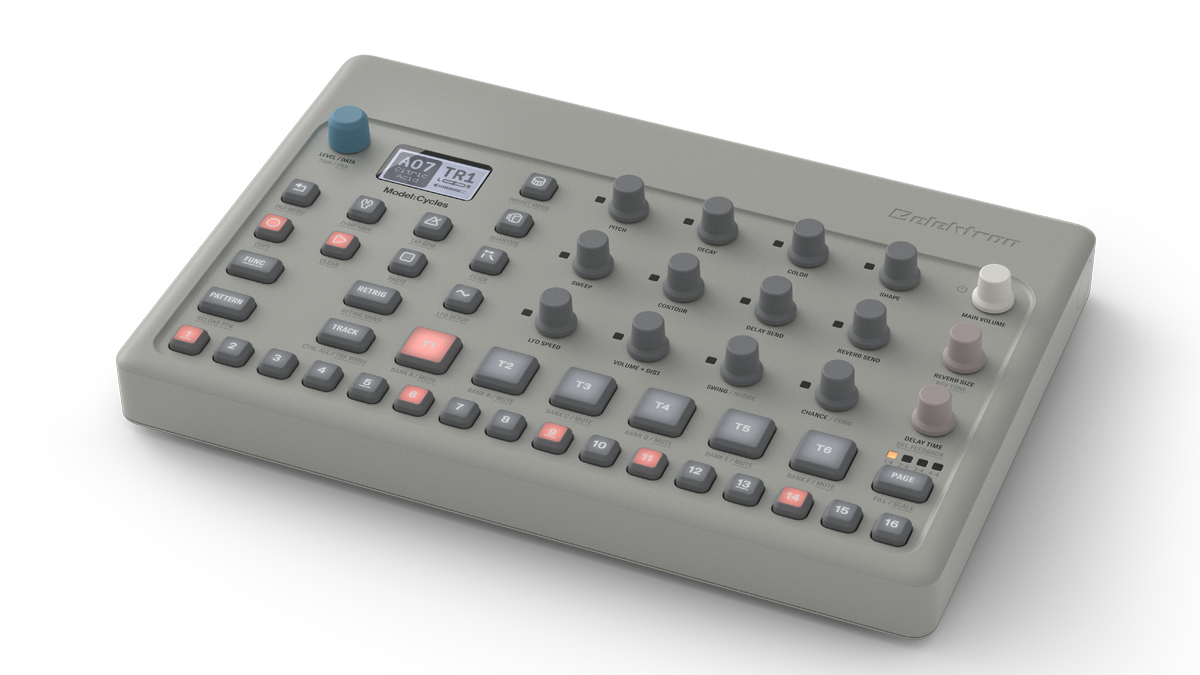
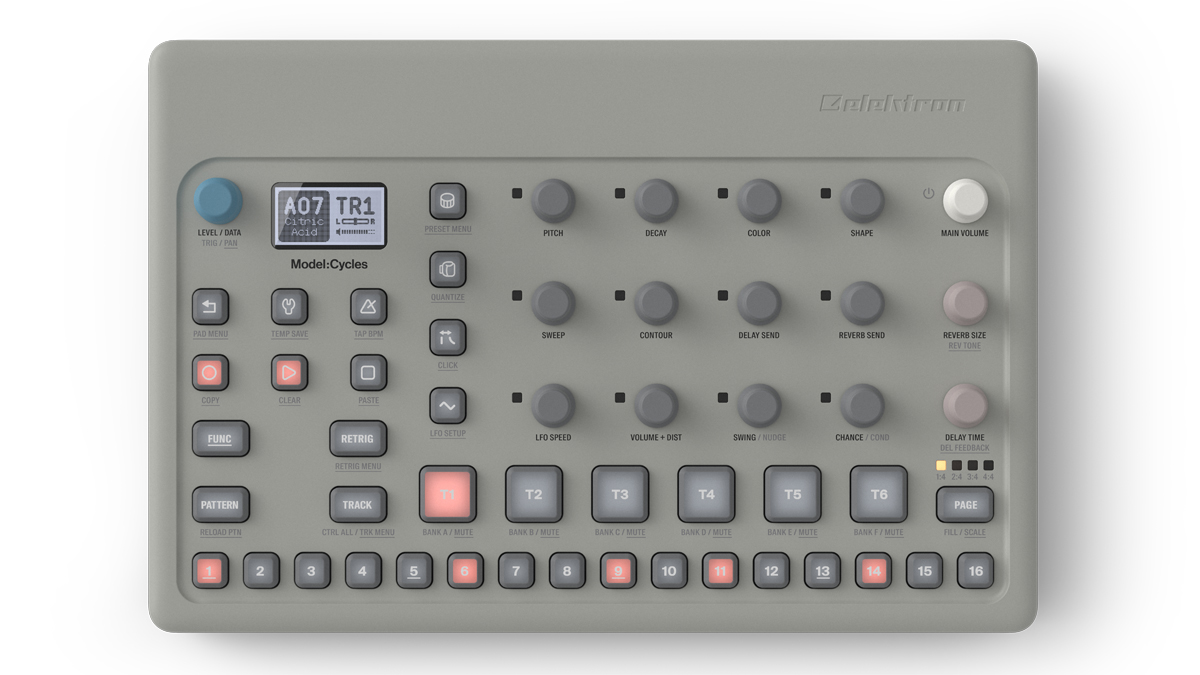
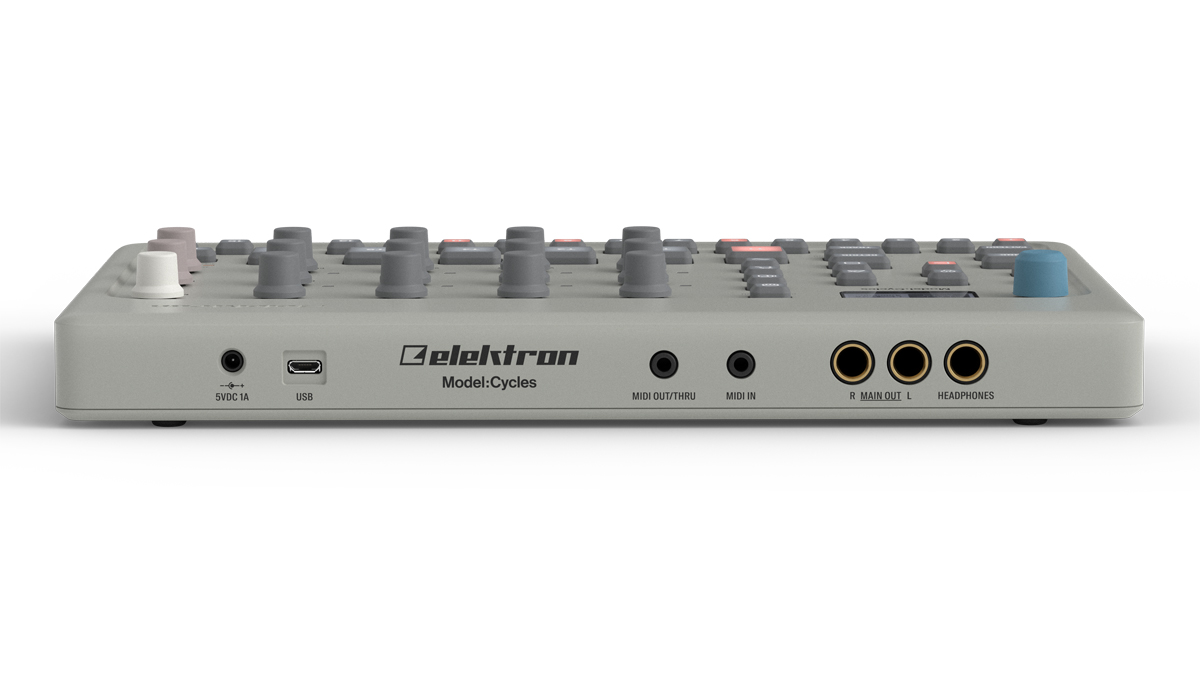
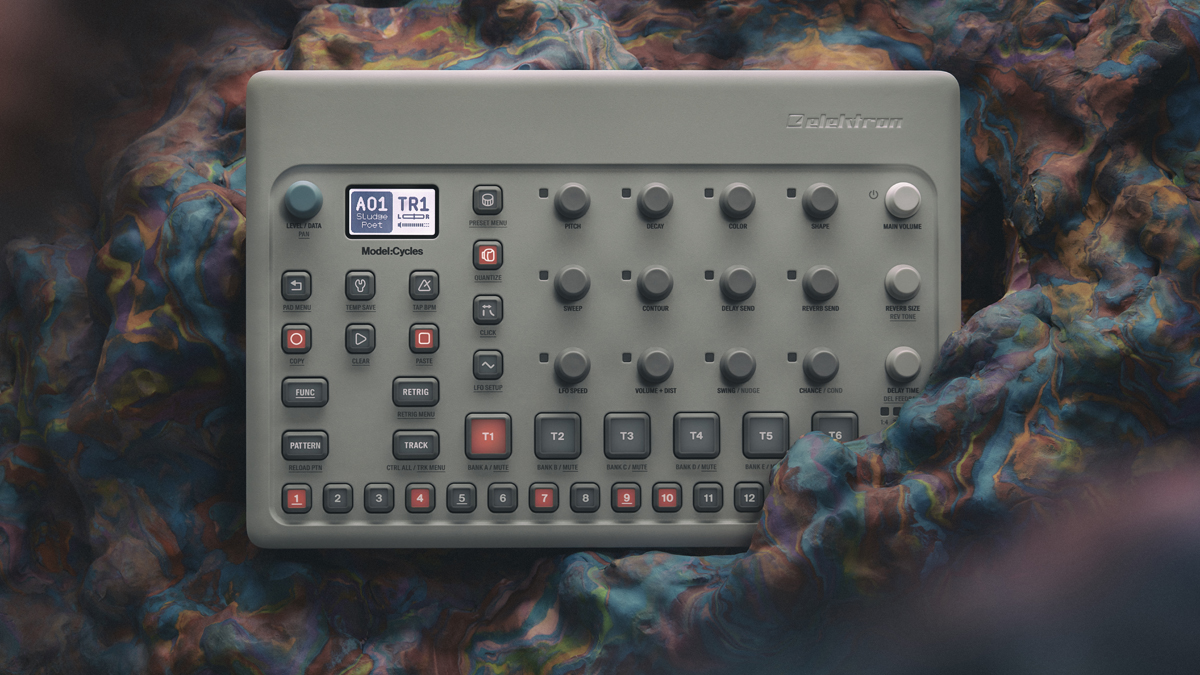
As with Model:Samples, the real highlight here is the sequencer. Each track has its own 64-step sequencer lane, the length and rate of which can be set individually. Elektron’s Parameter Locks feature allows for full per-step automation of all front-panel controls. This can even be used to change Machines mid-sequence, meaning a single track can be used to sequence multiple sounds.
Best of all is the inclusion of the Chance Parameter and Conditional Locks. These allow for deep control over the probability and conditions that dictate whether a hit will play on any sequencer step. It’s a wonderfully handy tool for adding variety and interest to otherwise static grooves and, with a dedicated front panel control, it’s at its most useable and intuitive here.
There are a few weak spots to the device. Primarily, the lack of individual outputs is a disappointment. Given the price point, it’s fairly understandable that there’s just the one stereo pair of main hardware outs (plus a headphone output) but Model:Cycles can also be used to stream audio directly over USB to a DAW, and its a shame that this is limited to just two channels. Full virtual track outs, plus outputs for the delay and reverb auxiliaries, would really add to the device’s usability in the studio.
This remains a really enjoyable and powerful groovebox, though, and it’s well-priced, too. Unlike its predecessor Model:Samples, which felt very-much like a cutdown Digitakt, this is more than just a truncated version of the Digitone. The design of the Machines and selection of front panel controls give Model:Cycles its own distinct, percussive flavour and creative workflow. While its sound might not suit everyone, we're sure it will win over plenty.
MusicRadar verdict: More than just a cut-down Digitone, this is a fun and personality-packed FM groovebox driven by a fantastic sequencer.
Hands-on demos
Thomann Synthesizers
Elektron
Red Means Recording (no talking)
Specifications
- 6 × FM based Machines
- 1 × Assignable LFO per track
- 1 × Assignable velocity modulation per track
- Storage space for up to 60,000 presets
- 6 × Audio tracks (all of which may be used as MIDI tracks as well)
- Elektron sequencer with up to 64 steps
- Unique length and scale settings per track
- Parameter locks
- Micro timing
- Trig conditions
- Assignable retrig
- Real-time or grid recording of notes and parameters
- 96 × Projects
- 96 × Patterns per Project
- Send & master effects
- Delay and reverb send FX
- 6 × Velocity sensitive pads
- Class compliant USB audio 2.0
- 1 × 1/4” stereo headphone jack
- 2 × 1/4” impedance balanced audio out jacks
- 1 × Hi-speed USB 2.0 Micro B port
- 3.5 mm dual polarity TRS MIDI In, Out/Thru jacks
- 128 × 64 pixel LCD screen
- 48 kHz, 24-bit D/A converters
- Hi-speed USB 2.0 Micro B port
- Power inlet: Center positive 3.5 × 1.35 mm barrel jack, 5 V DC, 1 A
- Battery In: Center positive 5.5 × 2.1 barrel jack, 4–10 V DC
- 2 × slots for attaching Power Handle BP-1 (battery pack to be released at a later date)
- W 270 × D 180 × H 39 mm (10.7” × 7.1” × 1.6”) (including knobs and feet)
- Weight: approximately 0.80 kg (1.8 lbs)
I'm the Managing Editor of Music Technology at MusicRadar and former Editor-in-Chief of Future Music, Computer Music and Electronic Musician. I've been messing around with music tech in various forms for over two decades. I've also spent the last 10 years forgetting how to play guitar. Find me in the chillout room at raves complaining that it's past my bedtime.
“Every note counts and fits perfectly”: Kirk Hammett names his best Metallica solo – and no, it’s not One or Master Of Puppets
Ranked: Bon Iver's albums, from Sable, Fable to For Emma, Forever Ago
“Its mission is simple: unleash the power of any amplifier or line-level source without compromise”: Two Notes promises a “watershed” in tube amp control with the Torpedo Reload II
